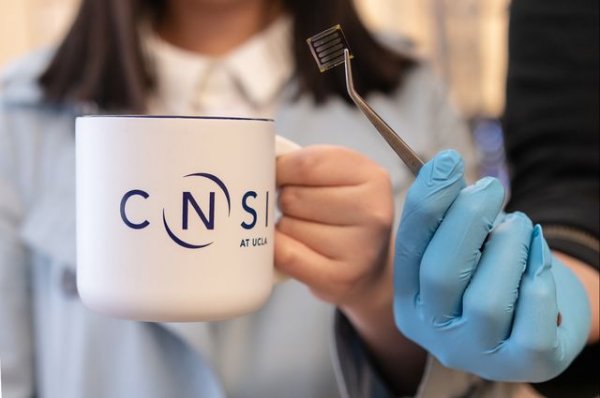*** Can also make solar cells more energy?

Adding *** to perovskite solar cells helps make it commercially viable, because this chemical enhances their ability to withstand the sustained high temperatures of sunlight.
Scientists at the California Nanosystems Institute at the University of California, Los Angeles have discovered that *** can improve the stability of perovskite solar cell materials at high temperatures. This characteristic is called thermal stability. Perovskite solar cells may one day replace traditional silicon-based solar cells.
The research was published today in the journal Joule and was led by Carol and Lawrence E. Tannas Jr. Professor of Engineering Yang Yang at the University of California, Los Angeles.
Over the past few years, perovskite solar cells have been considered the future of solar energy, because their production costs may eventually be lower than today's silicon solar cells, and they have the potential to improve energy efficiency. The research on perovskite solar cells can only be traced back to the early 2010s, but their efficiency is close to that of silicon solar cells, and the research of silicon solar cells has been carried out for more than 40 years.
But perovskite solar cells are not yet commercially viable, partly because they cannot withstand the continuous heat from sunlight.
Yang, a professor of materials science and engineering at the Samuel School of Engineering at the University of California, Los Angeles, said: "Solar cells require high thermal stability because they are often exposed to sunlight, which heats up the device." "Although perovskite is solar An attractive option for batteries, but over time, this material will degrade and become less stable. We need them to be used for 20 to 30 years like traditional solar cells. "
Perovskite solar cells are named not because they contain perovskite minerals, but because their crystal structure mimics the molecular structure of perovskite. They contain an ultra-thin film made of inexpensive materials such as methylammonium, lead, and iodine. The combination of these inexpensive materials produces this crystal structure.
It is this structure that makes solar cells very effective in converting photons (the basic unit of light) into electrical energy.
In March 2018, UCLA graduate student Wang Rui (transliteration) and some colleagues had coffee together and came up with the idea of ​​testing *** as a possible solution to the thermal instability of perovskite cells. He considered the chemical structure of *** and wondered whether it could interact with the materials used in perovskite solar cells.
"*** 's boiling point is 300 degrees Celsius, which is higher than the operating temperature of solar cells, so it seems to be a possible choice," said Wang, one of the study's first authors.
To test whether *** can improve the thermal stability of the device, the research team made a customized perovskite film by mixing dimethylformamide, methylammonium iodine and lead iodide to create a liquid solution, adding ***, and then putting The solution to the indium tin oxide glass forms a layer of black perovskite.
They implanted the new film into a solar cell and placed it on a flat panel heated to 85 degrees Celsius (about 185 degrees Fahrenheit) to test its ability to withstand high temperatures. During two months, its energy output was measured every four days. The researchers found that the thermal stability of the device was maintained for more than 1300 hours, which is 55 days, while retaining 86% of the energy-this A measurement method is called energy conversion efficiency.
For comparison, the research team also tested a perovskite solar cell without ***; after 175 hours, that is, about 7 days later, it retained only 60% of the power conversion efficiency.
In order to understand the mechanism of ***, the research team used transmission electron microscopy to analyze the evolution of the new thin-film crystal structure. They determined that there was a strong interaction between *** and lead ions-a "molecular lock".
"Part of the chemical structure of *** forms a strong bond with lead ions and stabilizes the crystal," said Xue Jingjing, a graduate student at the University of California, Los Angeles and another first author of the study. "The molecular lock between *** and lead also slows the growth of perovskite crystals, arranging them in a direction that facilitates charge transfer."
With the understanding of the molecular lock effect formed by *** molecules, researchers can now explore whether other chemicals besides *** can produce similar effects to further improve the thermal stability of perovskite cells.
"This molecular lock may help promote the commercialization of perovskite solar cells in the future," Yang said. "*** is the first compound we discovered, but there may be other compounds that work more effectively."
Yang's research team has been studying perovskite and other types of solar cells for many years. Its recent achievements include the development of a double-layer solar cell that generates more energy from sunlight than ordinary solar panels.
This research was developed by the U.S. Air Force Office of Scientific Research, U.S. Naval Research Office, University of California Institute of Advanced Solar Energy Technology, China ’s Natural Science Foundation, Suzhou Nanotechnology Collaborative Innovation Center, Jiangsu Higher Education Institution ’s priority academic program Jinzhou Sunshine Energy.
We provide some different purity of Alumina Ceramic Tube, like 95%, 99%, 99.5% and 99.7% that it related to the specia requirement and application.
We are capable of dealing with customized service via fine grinding, maching, polishing according to clients' drawing, specification and practical samples.
Alumina Ceramic Tube
Alumina Ceramic Tube,Alumina Ceramic Thermocouple Tube,Dry Pressing Alumina Ceramic Tube,Industrial Ceramic Alumina Tube, Alumina Ceramic Bushing, Alumina Ceramic Sleeve, Alumina Ceramic Pipes
Jinghui Industry Ltd. , https://www.ceramictek.com